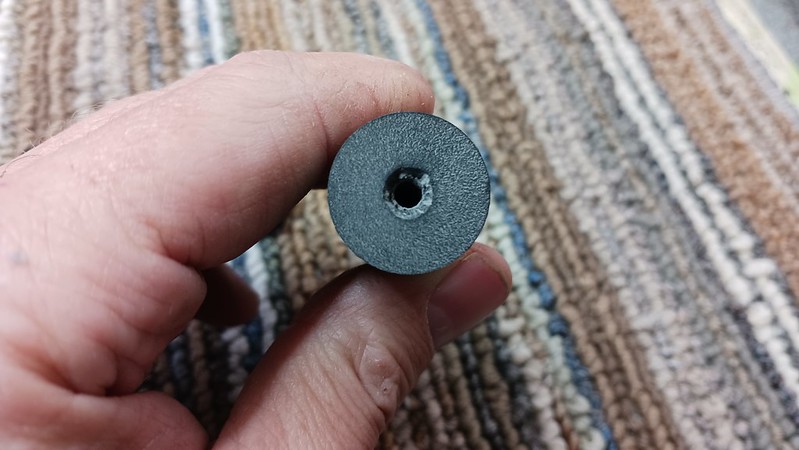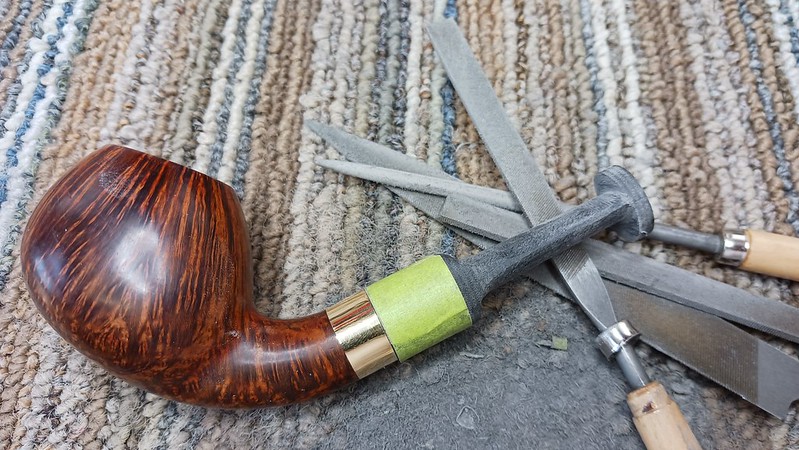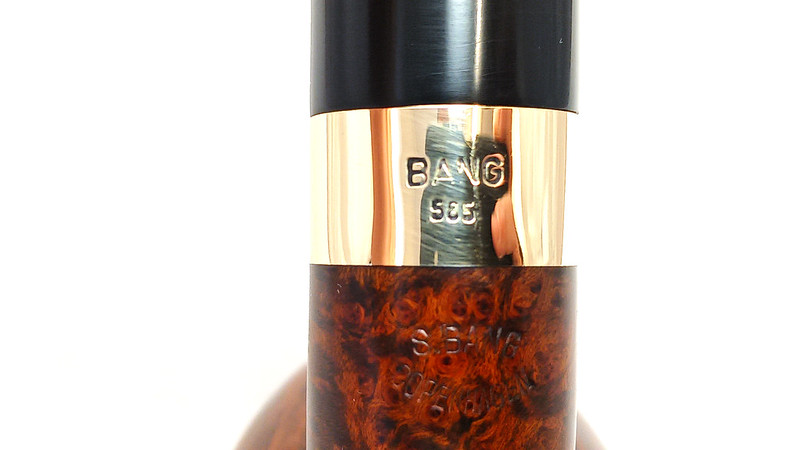One of the perks of doing what I do here at DadsPipes is having the opportunity to work on some very high end artisan-grade pipes that I cannot afford to buy for my own rack and rotation. One example is this lovely Danish hand made S. Bang that was sent to me for repair.
As the initial series of pics show, the problem with the pipe was a common one – the tenon, in this case one made to fit a 9mm filter, had broken and a piece was missing. After discussing the project with the pipe’s steward, it was decided that my repair would be two-fold – a new tenon would be made up and installed in the original Vulcanite stem, and a new acrylic stem would also be made.
Unfortunately, when I went to order the rod stock, I discovered that the shank on this pipe was a few millimeters larger than the available rod options. That shut down the acrylic discussion pretty quickly, but after a bit of digging, an alternative material was found – Eldritch Resin rod, sold through Rawkrafted.com. The rod is described as follows:
Eldritch Cumberland is a Resin Product designed to echo the grained look of traditional Ebonite Cumberland/Brindle but in vibrant colors, more usually seen in acrylic and other thermo plastics. Eldritch Cumberland has a similar hardness to Ebonite, and it is a little lighter. It is easy to bend with careful heat and patience. A delrin tenon is recommended over cutting a tenon. Easy to polish to a mirror shine with traditional sanding and buffing, and it machines well. Eldritch Cumberland will not oxidize, and it will keep its finish well.
– from Rawkrafted.com
After a discussion with the pipe’s steward, it was decided that a new stem would be made from Eldritch Cumberland Resin rod in Black. I placed the order and in due time the rod stock arrived at DadsPipes. I had cleaned the stummel while waiting for the rod stock to come in, so I wasted no time getting down to business.
The first step in making a stem from rod is to cut a piece to length. I added about 2mm to the overall length of the piece to account for the material that would be lost facing the rod on the lathe. This pic shows the original stem next to the raw section of rod stock.
The next set of operations use the lathe to turn the rod stock to rough diameter. I like to leave it a hair oversized for a bit of wiggle room if the shank is slightly out of round. Then a series of four (4) drill bits are used to create the airway. I use a 1/16″ starter bit to dimple the centre of the rod stock. This provides a pilot hole for a long 1/8″ drill bit that drills the majority of the airway, but stops about 5/8″ shy of the button end of the stem. A 9/64″ taper-point bit is then used to slightly enlarge the airway diameter and bring the far end of the shaft to a fine point. This point acts as a guide for the final drill bit, a long 1/16″ diameter bit that bores the final distance through to the button.
At the button end of the new stem, I cut a started slot using a small Dremel cutting wheel. This rough cut slot establishes the orientation of the stem on the shank – key to getting the stem straight.
At the shank end of the stem, the rod stock must be drilled out to accept a 9mm Delrin tenon, which I also make to order in the shop.
A bit of two-part epoxy secured the tenon in the stem face. Once the glue had cured, I could make a first test fit. Looking good! The rod stock is centred on the shank and the junction between stem and shank is light-tight.
Then it was time to start shaping the rod into a pipe stem. I used thin strips of painter’s tape to map out the basic lines of the stem. This will be a saddle stem, so I taped out the depth of the saddle, a slightly oversized strip at the opposite end for the button, as well as a centre line down both sides of the rod using the slot and tenon to keep the tape straight.
With my guide lines marked out, I used the belt sander to remove the bulk of the excess material relatively quickly.
From here on out, all the work to cut and refine the shape of the new stem is done by hand with files and sandpaper. This is the time consuming part of making a hand cut stem. These next pics show different points in the progress.
When I was happy with the size and shape of the stem, button and slot, I warmed the stem over the heat gun and applied a bend to match the original stem. The pipe cleaner run through the stem is cheap insurance against the airway collapsing while the resin is warm.
Then it was time to remove the last sanding scratches and bring the pipe to the buffer for final polishing. I gave it a run on the Red Tripoli wheel then buffed the entire pipe on the White Diamond wheel before applying a few light coats of Carnauba wax to shine and protect the finished pipe.
While not my first hand cut stem, this was the first I have made from Eldritch Resin rod. I found it easy to work, both by hand and on the lathe, and it polished up rather well too. All in, the resin rod offers a good alternative to acrylic for pipe stewards who wish to avoid Ebonite.
Thanks for joining me for this restoration project. This was an interesting one for me, both for the novel stem material and the pipe for which the stem was crafted. I hope you enjoyed following along.
Until next time, Happy Piping! Here’s the finished pipe.




























I would like to know the differences between ebonite v. acrylic v. Eldritch cumberland in regards to durability; costs and how it sits in the mouth. I have found acrylic durable but hard, is eldritch a happy medium between acrylic and ebonite?
LikeLiked by 1 person
Raw material cost is about the same for Eldritch Cumberland and Japanese Ebonite, though German NYH and SEM Ebonite are more expensive. Acrylic rod is slightly cheaper than the Eldritch rod but much harder to work so labour cost is higher for acrylic.
Regarding durability and mouth feel, Eldritch rod is about the same hardness as Ebonite but will not oxidize. This was my first experience using Eldritch rod stock so I don’t have direct knowledge of how resistant it is to tooth dents, but anecdotal evidence suggests it holds up at least as well as Ebonite.
LikeLike
Thank you. Next time I will most likely try this new material just as an experiment on one of my pipes.
LikeLiked by 1 person